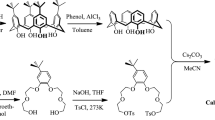Abstract
The radiolytic stability of 25,27-bis(2-propyloxy)calix[4]-26,28-crown-6(iPr-C[4]C-6) was studied. The radiation source was 60Co and its dose rate was 437 Gy/min and the total absorbed dose was from 104 to 106 Gy. The iPr-C[4]C-6 solid and 0.025 mol/L iPr-C[4]C-6/n-octanol which were pre-equilibrated with 0.01 and 3 mol/L nitric acid, respectively, were absorbed different dose and their extraction performance were researched. The degradation mechanism of them was investigated by mass spectrometry and infrared spectrum. The results show that radiolytic stability of the iPr-C[4]C-6 solid and 0.025 mol/L iPr-C[4]C-6/n-octanol are good when their absorbed dose was less than 106 Gy. The extracting system of iPr-C[4]C-6/n-octanol is promising for separating cesium from high level liquid waste.










Similar content being viewed by others
References
Zhu X , Gao J, Wang J (2002) The progress of researching the extraction of cesium by calixcrown from high level liquid waste. Chin At Energy Sci Technol 36(3):238–245
Gao J, Zhu X, Wang J (2002) The complexing ability of calixcrown to cesium and its application in treating waste solution containing radioactive cesium. Chin Org Chem 22(2):115–122
Thuery P, Nierlich M, Lamare E et al (2000) Bis(crown ether) and azobenzocrown derivatives of calix[4]arene: a review of structural information from crystallographic and modeling studies. J Incl Phenom Marcrocycl Chem 36(4):375–408
Simon N, Eymard S, Tokurnois B et al. (2000) Cesium extraction from acidic high level liquid waste with functionalized calixarenes, ATALANTE 2000, Avinon France. Paper 02–06:24–26
Bruce AM, Peter VB, Latitia HD et al. (1999) Solvent extraction of Tc and Cs from alkaline nitrate wastes, ISEC’99. Barcelona, pp 1,365–1,370
Bonnesen PV, Delmau LH, Moyer BA et al (2000) A robust alkaline-side CSEX solvent suitable for removing cesium from Savannah river high level waste. Solvent Extr Ion Exch 18(6):1079–1107
Feng W, Yuan LH, Zheng SY et al (2000) The effect of p-tert-butylcalix[n]arene on γ-radiation degradation of polypropylene. Radiat Phys Chem 57:425–429
Xiaowen Z, Jianchen W, Chongli S (2004) Novel extractant calixcrown used in high-level liquid waste (II)—extractive capability of bis(2-propyloxy)calix[4]crown-6 in different solvents. Chin At Energy Sci Technol 38(1):21–24
Author information
Authors and Affiliations
Corresponding author
Rights and permissions
About this article
Cite this article
Wang, J., Zhu, X. & Song, C. The study of radiolytic stability of 25,27-bis(2-propyloxy)calix[4]-26,28-crown-6(iPr-C[4]C-6). J Radioanal Nucl Chem 293, 851–855 (2012). https://doi.org/10.1007/s10967-012-1760-8
Received:
Published:
Issue Date:
DOI: https://doi.org/10.1007/s10967-012-1760-8




